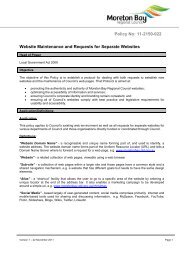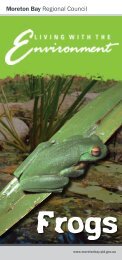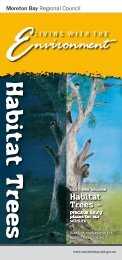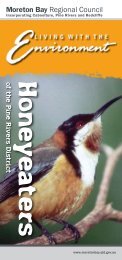Groundsel bush Baccharis halimifolia - Moreton Bay Regional Council
Groundsel bush Baccharis halimifolia - Moreton Bay Regional Council
Groundsel bush Baccharis halimifolia - Moreton Bay Regional Council
Create successful ePaper yourself
Turn your PDF publications into a flip-book with our unique Google optimized e-Paper software.
Description and general information<strong>Groundsel</strong> <strong>bush</strong> is a densely branched shrub usually nomore than 3 m high. Stems are green, maturing to brownand woody. Bark of mature plants is deeply fissured.Leaves are dull green, alternate, wedge shaped, 2.5–5 cmlong and 1–2.5 cm wide, with a few lobes in the upper part.It has a deep branching taproot with numerous fibrouslaterals in the upper soil.Male and female flowers are borne on separate plants.Male flowers are pale yellow and open around mid tolate March, slightly earlier than the female flowers.Female flowers are white and inconspicuous at the end ofbranches until seeds are fully developed. Then the planthas a fluffy appearance, with tufts of white hair (aroundlate March to early April) that begin to blow the fluffyseeds in the breeze from mid to late April.Seeds germinate readily with rainfall; however, if theybecome buried they can remain dormant for several years.Seeds are readily transported by wind, running water,vehicles and machinery. Soil disturbance in infestedareas usually leads to substantial germination. Furtherinfestation occurs unless the ground is sown to pasture orother competitive ground cover.PreventionThe spread of groundsel <strong>bush</strong> threatens the sustainabilityof agriculture and other land uses. <strong>Groundsel</strong> <strong>bush</strong> canreplace plants and destroy habitat for native wildlife.The best form of weed control is prevention. Always treatweed infestations when small—do not allow weeds toestablish. Weed control is not cheap, but it is cheaper todo it now rather than next year, or the year after. Propermanagement planning ensures you get value for eachdollar spent.ControlLook at your weed problem carefully. Can you realisticallyeradicate it? Or should you contain the weed to stop newinfestations developing while you reduce existing ones?What are you required to do by legislation? How does weedcontrol fit into your property management plan? What canyou do to restore areas and prevent re-establishment?The best approach is usually to combine differentmethods. Control may include chemical, mechanical, fireand biological methods combined with land managementchanges. The control methods you choose should suit yourparticular situation.Habitat and distribution<strong>Groundsel</strong> <strong>bush</strong> is a native of Florida (United States) andcoastal areas adjacent to the eastern side of the Gulf ofMexico.It was introduced into the Brisbane region as anornamental plant in 1900 and has spread along the coastalareas of south-east Queensland (north to Miriam ValeShire) and down the New South Wales coast. Scatteredplants have occurred as far west as the Chinchilla region.<strong>Groundsel</strong> <strong>bush</strong> is a rapid coloniser of cleared, unusedland and is particularly suited to moist gullies, salt marshareas and wetlands. It also does well on high, clearedslopes.Most germination occurs in the autumn/winter period.Plants normally do not flower in the first year of growth.Plants that are 2m tall can produce from 500 000 to amillion seeds.Seeds from mature plants drift in the breeze like thistleseeds, most falling within a few metres of the parent <strong>bush</strong>.Wind updrafts can carry seeds many kilometres.Management strategiesIn grazing situations, good pasture management willgreatly reduce groundsel <strong>bush</strong> invasions. Slashing, timelyuse of fertiliser and management of stocking rates canassist in control by maintaining a healthy pasture. Goodpastures provide competition to limit re-invasion ofgroundsel <strong>bush</strong>es. Consult Department of Employment,Economic Development and Innovation (DEEDI) pastureagronomists on the best options for your property.For tall, dense infestations, burning can reduce theamount of above-ground material (and even kill the oddplant) making it a lot easier to spray regrowth. Annualburning does not reduce existing plant numbers, butallows grasses to establish more quickly and out-competegroundsel <strong>bush</strong> seedlings.Regular slashing over a period of several years willresult in a decreased level of infestation. In non-grazingsituations, reforestation will eventually assist in controlof groundsel <strong>bush</strong>. However, it is important to ensure thatseed production is prevented while trees are establishing.2 <strong>Groundsel</strong> <strong>bush</strong> <strong>Baccharis</strong> <strong>halimifolia</strong>
4. <strong>Groundsel</strong> <strong>bush</strong> leaf beetle (Trirhabda baccharidis)—This beetle is restricted to similar habitats to the stemborer, where the larvae can form suitable cocoonsand pupate in the soil. Plants will be totally defoliatedin autumn, but can recover and are in full leaf nextspring. In some years larvae severely damage the budsand flowers.5. Leaf skeletoniser (Aristotelia ivae)—The larvae of thismoth eat the soft leaf tissue leaving the skeletal woodyveins. Though widespread, populations do not becomelarge enough to cause significant damage. It is mostcommonly found in the spring on new leaves.6. Leaf miner (Buccalatrix iveila)—The larvae of this smallmoth mine in the leaf blades and later skeletonise theleaves in a manner similar to Aristotelia. This insect iswidespread within the range of groundsel <strong>bush</strong> andcauses minor damage.Recent research has seen a move away from insectbiocontrol to plant disease biological control agents. Twodiseases have been studied in Florida. Experimental fieldreleases of the rust fungus Puccinia evadens from Floridacommenced in 1998 and this pathogen is now establishedat several sites.<strong>Groundsel</strong> <strong>bush</strong> rust (Puccinia evadens) acts as both aleaf and stem parasite, causing defoliation during summerand winter and stem dieback over summer. The infectionprocess requires a moisture film on the leaf or stemsurface. The dry spores are spread by wind.Biological controlSince the biological control program began for groundsel<strong>bush</strong> in 1967, over 35 different insects have been testedbut only six have become permanently established inthe field:1. Stem borer (Megacyllene mellyi)—This beetle isrestricted to areas adjacent to salt marshes wherethe sap flow in the host plant is lower. Newly hatchedlarvae are drowned by the heavier sap flow in plantsgrowing in non-saline soils. Dense populations ofthis insect can reduce groundsel <strong>bush</strong> infestations insuitable habitats.2. Plume moth (Oidaematophorus balanotes)—This insectis present in all areas. Damage is caused by larvaetunnelling in the stems and varies from severe diebackto death of individual branches. Populations of the mothappear to be restricted by ant predation on the eggs andyoung larvae. This in turn restricts plant damage.3. Gall-fly (Rhopalomyia californica)—The larvae of thismosquito-like fly feed within development shootsand buds. Initially this insect caused heavy damagewhen it was released. However, soon after its releaseit was attacked by a small native wasp that drasticallyreduced gall numbers. Galls can always be found in lownumbers, but occasionally higher numbers are found inpatches. Overall damage to the plant is minimal.The presence of these biocontrol agents does not relievelandholders from their responsibility under Queenslandlegislation to control declared plants.Mechanical controlHand-pull small plants. Dig larger plants out or cut themoff more than 10 cm below ground level.As groundsel <strong>bush</strong> is a perennial woody plant withunderground growing buds, slashing or burning will rarelykill plants and such action will generally result in regrowthoccurring. Therefore the regrowth will need to be promptlycontrolled.Herbicide controlBefore using any herbicide, always read the label carefully.All herbicides must be applied strictly in accordance withthe directions on the label.Table 1 details the herbicides registered for groundsel<strong>bush</strong> control.Further informationFurther information is available from your localgovernment office, or by contacting BiosecurityQueensland (call 13 25 23 or visit our website atwww.biosecurity.qld.gov.au).<strong>Groundsel</strong> <strong>bush</strong> <strong>Baccharis</strong> <strong>halimifolia</strong> 3


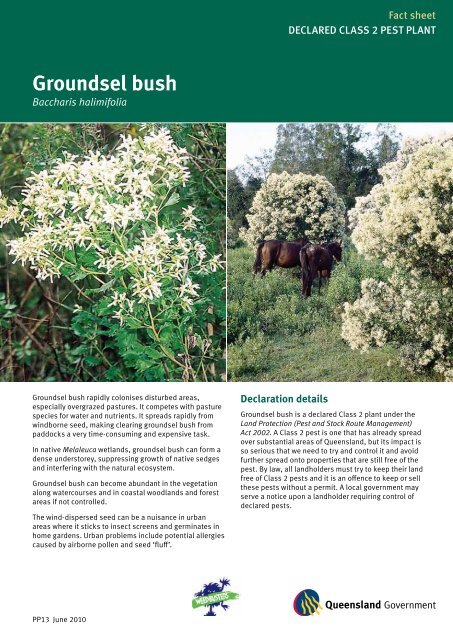
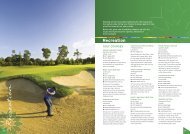
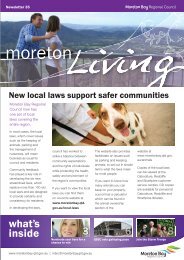
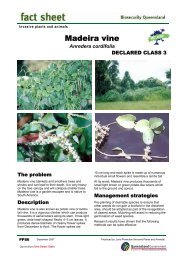
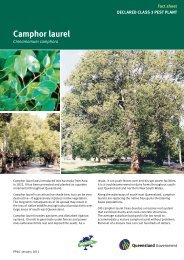


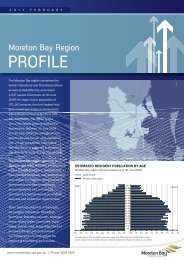
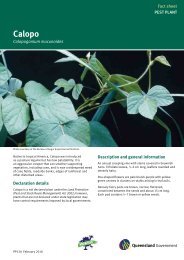

![Kumbartcho Brochure [PDF 540KB] - Moreton Bay Regional Council](https://img.yumpu.com/47220970/1/190x101/kumbartcho-brochure-pdf-540kb-moreton-bay-regional-council.jpg?quality=85)
